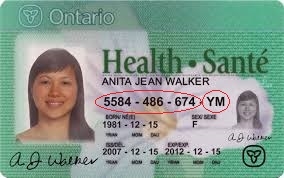Healthy citizens are a nation’s greatest asset said Winston Churchill and the Government of Canada bears the onus to ensure all its citizens and residents have access to a publicly funded, superior health care system in each of its provinces and territories. The Ontario Government provides each and every resident of Ontario with a comprehensive health coverage plan that caters to most medical needs. This coverage comes from the money collected as part of your taxes.

If you are new to Ontario, one of the first things you should do upon your arrival is to apply for the health card or
OHIP. You can only apply for OHIP, if you are a resident of Ontario and plan to live here for at least 22 weeks in a year. Physical presence in the province is mandatory for the first 6 months with a 30 day exemption for travel. To apply for your OHIP you need to go to your nearest Service Ontario Centre. These centres are all around the
GTA. Fill in your application form and submit it at the centre with proofs for ID, residence, citizenship status. Some documents you can use are record of landing, passport, drivers licence and lease agreement. Settlement service agencies also help new immigrants with their OHIP application process. Although you apply for a health card in the initial weeks of your arrival, the coverage does not begin immediately.
OHIP coverage will begin exactly 90 days after you land, reside or return to reside in
Ontario. Many people tend to question the need to wait for 3 months for getting their health card. The government uses this time to verify the status, residency and eligibility criteria before bearing the insurance expenses. This waiting period was made mandatory in 1994 to prevent fraud and misuse as many individuals never confirm their residency status.
Newcomers and immigrants must have a valid travel or health insurance for the first
three months. Many private players in the health insurance sector offer a wide range of policies and coverage plans depending on your age and medical history. Choose carefully from the plans available as there are some expenses that are not covered by these companies like pregnancy and childbirth related costs. A settlement worker can assist you in deciding what works best for your family. Another alternative is for you to buy one from your home country. If you are in Ontario to study or on a work permit your visa validity should be for at least 6 months for you to be
eligible to apply for OHIP. Dependants of these individuals are also eligible for coverage.
If you are arriving in Ontario from another Canadian province or territory, your valid health card from the former province should provide adequate coverage during the waiting period but there might be some restrictions depending on the province.
There is good news though. The waiting period does not apply for:
- Infants born in Ontario
- Children who have been adopted and are under the age of 16 provided they are OHIP eligible
- Those who come under the Interim Federal Health Program (IFHP) like refugees and protected people. (The Syrian refugees can breathe a huge sigh of relief)
- Those from another province/territory registering with a long-term care facility in Ontario, or plan to go into a long-term care facility shortly after arriving
To know if you fall under the exempted category check with your nearest
Service Ontario Centre.
It is important to know that there are limitations on your OHIP coverage even if there is no cap per se.
Services Covered by OHIP: Most of the basic medical and emergency services, consultations, hospitalization, surgeries, laboratory tests, mental illness counselling, prescription drugs (when hospitalized only), pre and post- natal care, medically advised nutrition and diet counselling and hypnosis are taken care of under OHIP. Eye examination is covered for people under 20 and above 65. For those between 20 and 65 with existing vision problems like glaucoma, cataract one eye exam every year is covered under OHIP. Some of the services like hypnosis are covered only if they are recommended as medically necessary by your Physician and you provide the proof of the same.
Services Partially Covered: Prescription drugs, ambulance services (surprised? me too!) physiotherapy for people under 19 and over 65, and some dental procedures if conducted in a hospital are partially covered. For those who live in Northern Ontario getting treated for special medical conditions would mean travelling to big cities and OHIP offers to bear a part of the travel costs. If you are travelling out of Canada travel insurance is the best option as medical costs in such cases may go way higher than what you are eligible for under OHIP.
 Services not covered
Services not covered:
- Crutches, casts, splints in case of injuries
- Cosmetic surgeries
- Dental treatments including fillings and braces
- Periodical eye exams for those between 20 and 64
- Prescription eye glasses, contact lenses, hearing aids
- Chiropractic treatments and massages
- Physiotherapy (if you are between the ages of 20 and 64)
- Alternate therapies like acupuncture, Reiki or homoeopathy
Another cost not borne by the government is medical record sharing. If your Family Physician is referring you to a specialist and they need access to your previous reports, charges may be applicable for sharing these reports and you have to bear the costs in this case. OHIP revises the coverage plan on a regular basis so check and keep tabs on changes made.
On the whole be reassured that your tax money is being utilized the best way possible and most of the services not covered under OHIP are usually supplemented as part of your employees benefit package. If you do not receive employee benefits then ensure you are covered by private insurance to pay for services such as eye and dental. Talk to your family physician or a healthcare professional, research and consider all aspects of the policy and narrow down on what works best for you and your family. Good health is priceless, so pay a small price and make an investment towards your personal wellness.

 If you are new to Ontario, one of the first things you should do upon your arrival is to apply for the health card or OHIP. You can only apply for OHIP, if you are a resident of Ontario and plan to live here for at least 22 weeks in a year. Physical presence in the province is mandatory for the first 6 months with a 30 day exemption for travel. To apply for your OHIP you need to go to your nearest Service Ontario Centre. These centres are all around the GTA. Fill in your application form and submit it at the centre with proofs for ID, residence, citizenship status. Some documents you can use are record of landing, passport, drivers licence and lease agreement. Settlement service agencies also help new immigrants with their OHIP application process. Although you apply for a health card in the initial weeks of your arrival, the coverage does not begin immediately.
If you are new to Ontario, one of the first things you should do upon your arrival is to apply for the health card or OHIP. You can only apply for OHIP, if you are a resident of Ontario and plan to live here for at least 22 weeks in a year. Physical presence in the province is mandatory for the first 6 months with a 30 day exemption for travel. To apply for your OHIP you need to go to your nearest Service Ontario Centre. These centres are all around the GTA. Fill in your application form and submit it at the centre with proofs for ID, residence, citizenship status. Some documents you can use are record of landing, passport, drivers licence and lease agreement. Settlement service agencies also help new immigrants with their OHIP application process. Although you apply for a health card in the initial weeks of your arrival, the coverage does not begin immediately.
 Services not covered:
Services not covered: